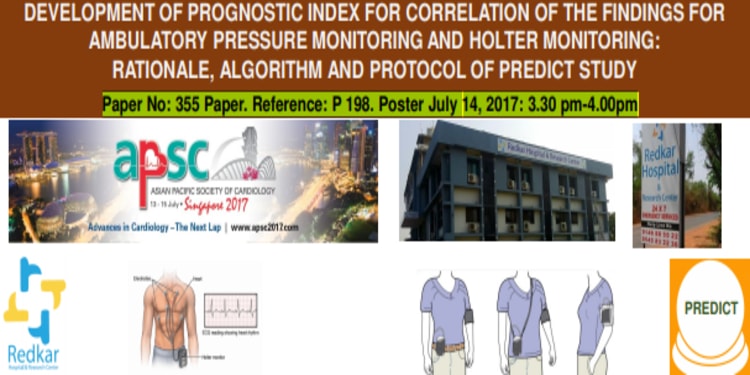Development of prognostic index for correlation of the findings for ambulatory pressure monitoring and holter monitoring

Authors:
Vivek Redkar1
Sagar Redkar2
Supriya Redkar2
Mohan Jagtap2
Darshan Khanolkar3
Sujatha Chogale2
Prasida Padate3
Shriram Kulkarni4
Navneet Wadhwa5
Institutions
1. Krishna Institute of Medical Sciences, Karad, Maharashtra
2. Redkar Hospital and Research Center, Oshalbag-Dhargal, Goa
3. Redkar Hospital Neuro Cardiac Center, Malvan, Maharashtra
4. Kulkarni Nursing Home, Khopoli, Maharashtra
5. AUW Global, Mumbai
Paper No: 355 Paper. Reference: P 198. Poster July 14, 2017: 3.30 pm-4.00pm
Introduction
• The evidence for the value of the association of the findings of simultaneous 24 hour Holter electrocardiography (ECG) monitoring with Ambulatory Blood Pressure Monitoring (ABPM) is limited
• Sympathetic overactivity during night is a well recognized factor of hypertension development in adults
• However, the deleterious effect of nocturnal autonomic activation in elderly remains controversial.
Objectives
• To develop a prognostic index based on a cost effective cardiovascular screening based on the correlation of circadian variability of BP with the 24-hour ECG monitoring for rate and rhythm of heart
Methods
• This proof of concept study in 500 patients at our tertiary care centre is developed as a mixed-methods approach in three steps
• First, patients reporting would be screened for hypertension
• Second, known hypertensives and the newly detected hypertensives as standard of care approach would undergo a simultaneous monitoring of 24-hour BP with Holter
• Third, these patients would undergo ABPM at home and followed up for five years to develop a prognostic index.
• The specific sub-groups that would contribute to the weighted score include hypertensives with cerebrovascular accident, accelerated hypertension, sleep apnea
Results
• The nocturnal BP monitoring is the rationale for determining the four sub-groups- normal dippers, non-dippers, extreme and reverse dippers. The primary outcome measures include the correlates for ST-T wave abnormalities, tachycardia and the patterns from recovery from stroke, improvement in cognitive scores, heart rate turbulence, association between the left ventricular mass and the dipping pattern
• The secondary outcomes measures would be based on the follow up for the outcomes for the hospitalisation for heart failure and cardiac death
Conclusions
• This would be the first study in Indian hypertensive patients for the development of a reliable prognostic index based on the triad of cardiovascular risk profile, the variability of the 24-hour BP and cardiac arrhythmic patterns
• The prognostic index based on the characteristic of the patient would be a guide for an efficient hospital initiated improvised home care follow up model for the effective management of hypertension
Bibliography
1. Int J Cardiol. 2012 Feb 23;155(1):155-9
2. Eur Heart J. 2013 Jul;34(28):2122-31, 2131a.
3. Nephrology (Carlton). 2016 Dec;21(12):1047-1055
